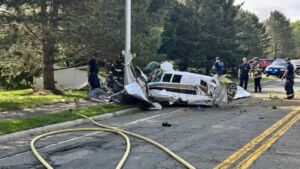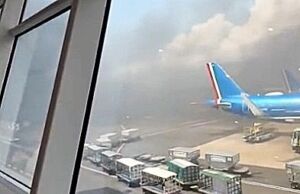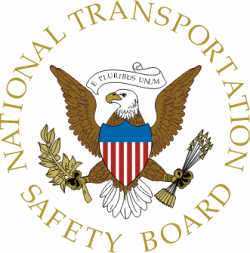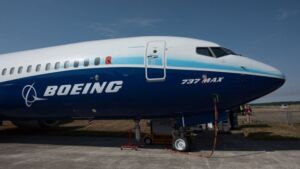Here are your stories for today...
Be safe out there!
Tom
One dead, 1 injured in small plane crash in Beverly
The crash occurred on Sam Fonzo Drive, near the Beverly Municipal Airport.
By Marc Fortier
One person has died and another person was injured in a small plane crash in Beverly, Massachusetts, on Thursday morning.
was injured in a small plane crash in Beverly, Massachusetts, on Thursday morning.
The crash occurred on Sam Fonzo Drive, near the Beverly Municipal Airport.
The Beverly Fire Department confirmed that two people were on board. They said one person was "non viable" and the other was taken by ambulance to Beverly Hospital. Their condition was not immediately known.
There is no fire, and fire officials the crash remains under investigation.
The Federal Aviation Administration said in a statement that the Mooney M20 plane with two people on board crashed around 7:45 a.m. They said they will investigate the crash, along with the National Transportation Safety Board.
Video from the scene showed the wreckage of the main portion of the plane in the middle of the street, with police and fire personnel surrounding it. Another piece of the plane was further off to the side of the road in the tree line.
A trail of dirt and debris could be seen strewn across the road, apparently in the path of where the plane made contact with the ground.
No further details were immediately available.
NTSB urges quick fix on Boeing plane engines to prevent smoke from filling cabin after a bird strike
Safety experts recommend that the engines on Boeing’s troubled 737 Max airplanes be modified quickly to prevent smoke from filling the cockpit or cabin after a safety feature is activated following a bird strike
By JOSH FUNK Associated Press
The Brief
-
- Safety experts recommend that
 the engines on Boeing’s troubled 737 Max airplanes and some Airbus models be modified quickly to prevent smoke from filling the cockpit or cabin after a safety feature is activated following a bird strike.
the engines on Boeing’s troubled 737 Max airplanes and some Airbus models be modified quickly to prevent smoke from filling the cockpit or cabin after a safety feature is activated following a bird strike.
- Safety experts recommend that
-
- The problem the National Transportation Safety Board detailed Wednesday emerged after two bird strikes involving Southwest Airlines planes in 2023 — one in Havana, Cuba, and another in New Orleans.
-
- The Federal Aviation Administration and Boeing have already warned airlines and pilots about the problem and the engine maker has been working on a fix.
Safety experts recommended Wednesday that the engines on Boeing's troubled 737 Max airplanes and some Airbus models be modified quickly to prevent smoke from filling the cockpit or cabin after a safety feature is activated following a bird strike.
The problem detailed by the National Transportation Safety Board emerged after two bird strikes involving Southwest Airlines planes in 2023 — one in Havana, Cuba, and another in New Orleans. The Federal Aviation Administration and Boeing already warned airlines and pilots about the problem and the engine maker has been working on a fix.
The NTSB said that the engines CFM International makes for the Boeing plane can inadvertently release oil into the hot engine when the safety feature, called a load reduction device, is activated after a bird strike or similar engine issue. The resulting smoke feeds directly into either the cockpit or passenger cabin depending on which engine was struck.
Air from the left engine on a 737 Max flows directly into the cockpit while air from the right engine flows into the passenger cabin.
The NTSB investigated a December 2023 incident in which a Southwest Airlines plane struck a bird while taking off from New Orleans and had to land quickly after thick smoke filled the cockpit — even making it hard for the pilot to see the instrument panel.
In an incident nine months earlier involving another Southwest 737 Max, smoke filled the cabin after a bird strike after takeoff in Havana.
While these incidents were both bird strikes, the NTSB said this could happen in certain other circumstances.
The FAA said in a statement that it agrees with the NTSB recommendations and when "the engine manufacturer develops a permanent mitigation, we will require operators to implement it within an appropriate timeframe."
Pilots can act to limit smoke in the plane by manually cutting off airflow from the engines, but smoke can quickly start to fill the cabin within a few seconds. The engine manufacturer is working on a software update that should do that automatically, but that’s not expected to be ready until sometime in the first quarter of next year.
Boeing and Airbus didn't immediately respond to requests for comment.
A Southwest spokesperson said the airline has been in close contact with the FAA, Boeing and the engine maker since the incidents and notified its pilots after they happened. The spokesperson said the airline continues to address the issue through its training and safety management systems.
The NTSB urged European aviation safety regulators to evaluate different models of these engines that are used to determine if they could also be susceptible to this smoke problem.
Although the NTSB said these engines are used on some Airbus A320neo planes, the Boeing 737 Max planes have been the focus since they were involved in both incidents, and there has been a history of other problems with that plane.
The Max version of Boeing’s bestselling 737 airplane has been the source of persistent troubles for Boeing after two of the jets crashed. The crashes, one in Indonesia in 2018 and another in Ethiopia in 2019, killed 346 people.
The problem in those crashes stemmed from a sensor providing faulty readings that pushed the nose down, leaving pilots unable to regain control. After the second crash, Max jets were grounded worldwide until the company redesigned the system.
Last month, the Justice Department reached a deal to allow Boeing to avoid criminal prosecution for allegedly misleading U.S. regulators about the Max before the two crashes.
Worries about the plane flared up again after a door plug blew off a Max operated by Alaska Airlines, leading regulators to cap Boeing’s production at 38 jets per month.
https://www.fox13seattle.com/news/ntsb-urges-fix-boeing-737-max-plane-engines
Fiumicino Airport: Terminal fire and blaze at Ponte Galeria halt trains, air traffic unaffected
AvioNews
Dense smoke invades the sky above "Leonardo da Vinci": prompt intervention prevents aircraft grounding
"Leonardo da Vinci": prompt intervention prevents aircraft grounding
The brush fire raging in Ponte Galeria persists. RFI announces the suspension of FL1 and Leonardo Express lines; disruptions affecting passengers traveling to and from the airport. Replacement bus services have been activated
A complex day for the western area of Rome, marked by a dual fire alert with significant repercussions on mobility, particularly affecting rail connections to Fiumicino Airport. Despite the disruptions, air traffic operations remained normal.
In the afternoon, around 2:50pm, a fire outbreak affected the roof of Terminal 1 of the "Leonardo da Vinci" Airport, specifically in the finger area of pier D. The flames, which according to initial reports involved a roofing membrane, were promptly extinguished. The joint intervention of the Fire Brigade, Aeroporti di Roma (AdR) personnel, and the Carabinieri quickly secured the area. Although a section of the boarding gates was temporarily evacuated as a precaution, airport authorities confirmed that flight operations were not interrupted, thanks to the swift activation of safety protocols.
Simultaneously, a larger and more persistent brush fire broke out in Ponte Galeria, in an uncultivated field near the railway line, between via della Muratella and the roundabout of via Eiffel. The flames, visible with a dense column of smoke, necessitated the immediate suspension of rail traffic on the Rome–Fiumicino Airport line.
Rete Ferroviaria Italiana (RFI) confirmed that from 2:00pm onwards, services on lines FL1 and Leonardo Express were interrupted on the section between Ponte Galeria and the airport. This caused unavoidable delays, restrictions, and cancellations for trains, resulting in significant inconvenience for passengers traveling to or departing from the airport. To mitigate the situation, substitute bus services were deployed.
Investigations are ongoing to determine the causes of both fires. While the incident at the terminal was contained and managed swiftly, the fire at Ponte Galeria continues to occupy the rescuers, highlighting the critical challenges that environmental events can pose to vital infrastructure.
Indy airport disaster drill tests crisis response
by: Reyna Revelle
INDIANAPOLIS (WISH) — A major emergency training drill took place at Indianapolis International Airport on Wednesday, simulating a disaster scenario to test the airport’s crisis response.
emergency training drill took place at Indianapolis International Airport on Wednesday, simulating a disaster scenario to test the airport’s crisis response.
The exercise, mandated by the Federal Aviation Administration (FAA) every three years, involved a staged plane crash at the International Arrivals Building. Over 425 participants, including public safety crews and airport operation teams, were involved in the drill.
“We are looking at the plan and making sure it’s the right plan and evaluating to see if there are ways to improve,” said Fred Pervine, chief of the IAA Fire Department. Matt Lewis, deputy senior director of operations and maintenance at IAA, emphasized the importance of realism in the exercise, stating, “Communicating on the radios and making sure we are all on the same page and executing our plan.”
The drill is designed to evaluate and improve the airport’s emergency response plan, ensuring preparedness for any potential incidents. Participants practiced various emergency procedures, including triage of victims and managing chaos in real-time. Despite recent aviation incidents, officials maintain confidence in the current emergency response plan.
The successful completion of the drill underscores Indianapolis International Airport’s ongoing commitment to safety and preparedness, ensuring that all teams are well-equipped to handle real-life emergencies effectively.
NTSB Prelim: Zenith STOL CH701
Purpose Of The Flight Was To Conduct A Test Flight Following The Airplane’s Reassembly And Inspection
Location: Geneva, OH Accident Number: ERA25FA211
Date & Time: May 25, 2025, 10:07 Local Registration: N514JG
Aircraft: Zenith STOL CH701 Injuries: 1 Fatal, 1 Serious
Flight Conducted Under: Part 91: General aviation - Flight test
On May 25, 2025, about 1007 eastern daylight time, an experimental, amateur-built Zenith STOL CH701, N514JG, was substantially damaged when it was involved in an accident near Geneva, Ohio. The pilot was fatally injured and the pilot-rated passenger sustained serious injuries. The airplane was operated as a Title 14 Code of Federal Regulations Part 91 test flight.
According to the pilot-rated passenger, who was also the owner of the airplane, he purchased the airplane in October 2024. He and the pilot subsequently removed the wings and transported the airplane to Germack Airport (7D9), Geneva, Ohio. The purpose of the flight was to conduct a test flight following the airplane’s reassembly and inspection. During the preflight inspection, the pilot ensured the flight controls were free and correct and no anomalies were noted during the engine run-up check.
The passenger reported that during the initial takeoff roll, “the airplane didn’t seem like it wanted to fly”, and the takeoff was aborted. The pilot taxied the airplane back to the departure end of runway 19 and initiated a second takeoff. The airplane became airborne approximately 1,800 ft down the 3,260-ft-long paved runway. During the initial climb, at an altitude of about 150 ft above ground level (agl), the airplane was unable to gain additional altitude. The pilot then pitched the nose down to gain airspeed, but the airplane was unable to maintain level flight. A surveillance video captured the engine sound consistent with operating power as the airplane descended to the trees in a nose-up attitude.
The airplane impacted trees and terrain about ½ mile southwest of the departure end of the runway. The first identified point of impact was a tree about 40 ft agl. The airplane came to rest in an upright position on a heading of about 330°, and about 30 ft from the initial point of impact. Several tree limbs located within the wreckage area exhibited angular cuts with black transfer marks in their separation areas. A postcrash fire ensued and consumed majority of the fuselage and right-wing fuel tank. All major components of the airplane were accounted for within the wreckage area. Both wings were partially separated from the fuselage and exhibited semicircular impressions to their leading edges. Flight control continuity was established from the cockpit controls to the rudder and elevator. The flaperon control was observed retracted and flight control continuity was established from the cockpit to the flaperon mixer assembly and bellcranks. The left and right flaperon control rods were impact separated from the flaperons.
About 10 gallons of fuel was recovered from the left wing. A fuel sample from the left wing was free of contaminants, and a test utilizing water-finding paste was negative for the presence of water. The fuel valve was noted in the on position and was confirmed functional during a field test using low-pressure air. Majority of the fuselage mounted fuel lines were thermally destroyed.
The engine remained attached to the fuselage with thermal damage noted to the accessory area of the engine. The spark plug electrodes were undamaged and displayed normal wear and coloration. Both magnetos produced spark from their ignition leads during hand rotation of the attached propeller. Crankshaft continuity was established from the propeller flange to the rear gears. Valvetrain continuity was established, and compression and suction were attained from all four cylinders.
No anomalies were noted to the induction air filter or exhaust system. The throttle control cable remained attached to the carburetor and was observed in the open position. The mixture control cable remained attached and was noted in the rich position. The carburetor fuel inlet screen was clear of debris. The three-bladed composite propeller remained attached to the engine. One propeller blade was separated at the hub area and the remaining two blades exhibited impact damage to their leading edges.
The wreckage was retained for further examination.
FMI: www.ntsb.gov

Today in History
78 Years ago today: On 19 June 1947 Pan Am flight PA121, a Lockheed L-049 Constellation, crashed near Mayadine, Syria, killing 14 occupants; 22 survived the accident.
| Date: | Thursday 19 June 1947 |
| Time: | 01:40 |
| Type: | Lockheed L-049 Constellation |
| Owner/operator: | Pan American World Airways (Pan Am) |
| Registration: | NC88845 |
| MSN: | 2045 |
| Year of manufacture: | 1946 |
| Total airframe hrs: | 2645 hours |
| Fatalities: | Fatalities: 14 / Occupants: 36 |
| Other fatalities: | 0 |
| Aircraft damage: | Destroyed, written off |
| Category: | Accident |
| Location: | near Mayadine - Syria |
| Phase: | En route |
| Nature: | Passenger - Scheduled |
| Departure airport: | Karachi International Airport (KHI/OPKC) |
| Destination airport: | Istanbul-Yesilköy Airport (IST/LTBA) |
| Confidence Rating: | Accident investigation report completed and information captured |
Narrative:
Pan Am flight PA121, a Lockheed L-049 Constellation, crashed near Mayadine, Syria, killing 14 occupants; 22 survived the accident.
The Constellation, named "Clipper Eclipse", was cruising at FL185 when the no. 1 prop had to be feathered due to engine problems. The remaining three engines overheated, forcing the crew to reduced power. This resulted in a gradual descent. The crew elected to continue to Istanbul instead of landing at the nearby Habbaniya RAF Station in Iraq. While descending through FL100 a fire broke out in the engine no. 2 nacelle. A rapid descent was started during which the no. 2 engine separated from the wing. With the left wing on fire a belly landing was carried out in the desert. It appeared the no. 1 engine failure was due to a broken exhaust rocker arm on the no.18 cylinder. The no. 2 engine failure was due to a failure of the thrust bearing which in turn resulted in blocking the passage of oil from the propeller feathering motor to the propeller dome.
PROBABLE CAUSE: "The Board determines that the probable cause of this accident was a fire which resulted from an attempt to feather the No. 2 propeller after the failure of the No. 2 engine thrust bearing."

 the engines on Boeing’s troubled 737 Max airplanes and some Airbus models be modified quickly to prevent smoke from filling the cockpit or cabin after a safety feature is activated following a bird strike.
the engines on Boeing’s troubled 737 Max airplanes and some Airbus models be modified quickly to prevent smoke from filling the cockpit or cabin after a safety feature is activated following a bird strike.